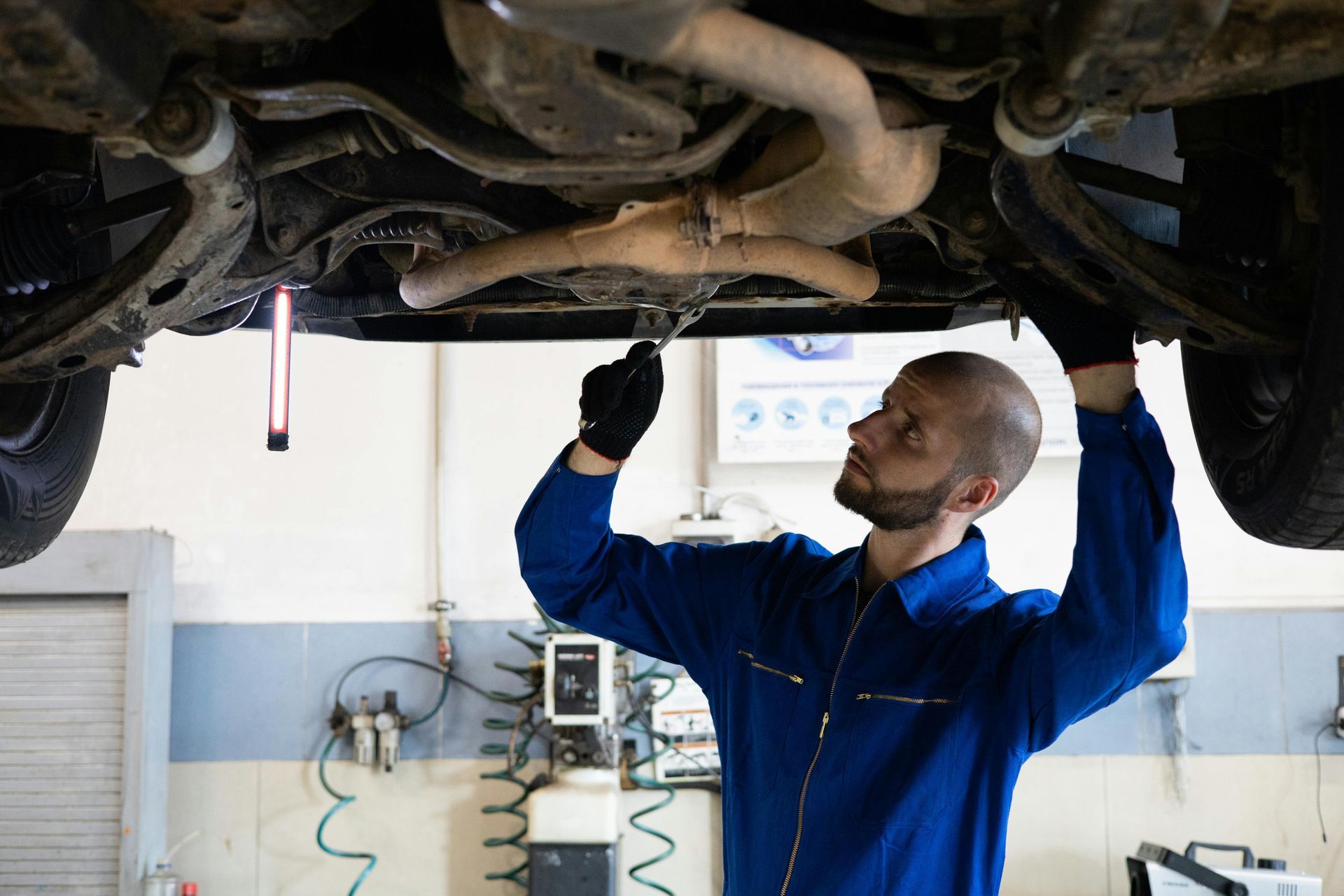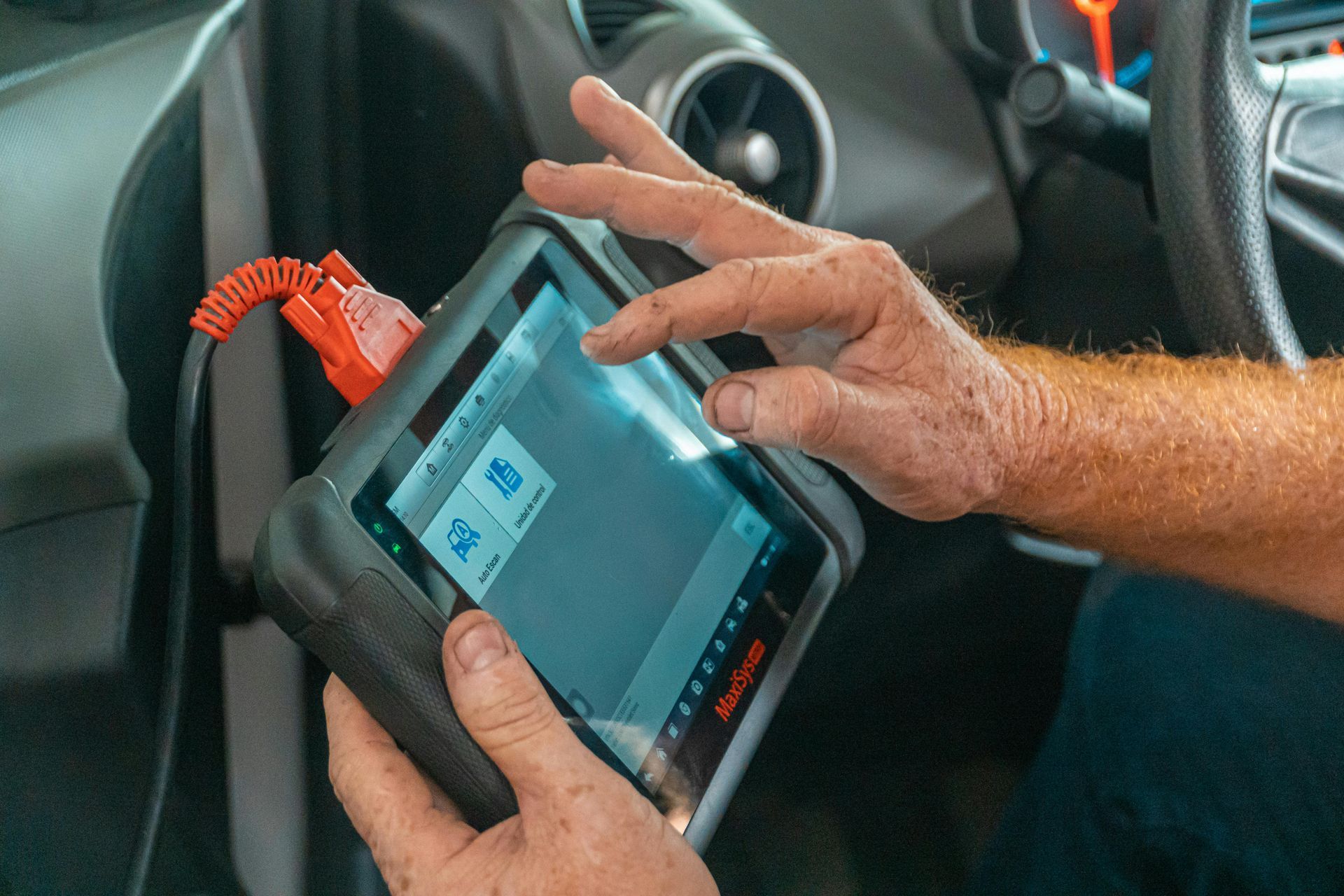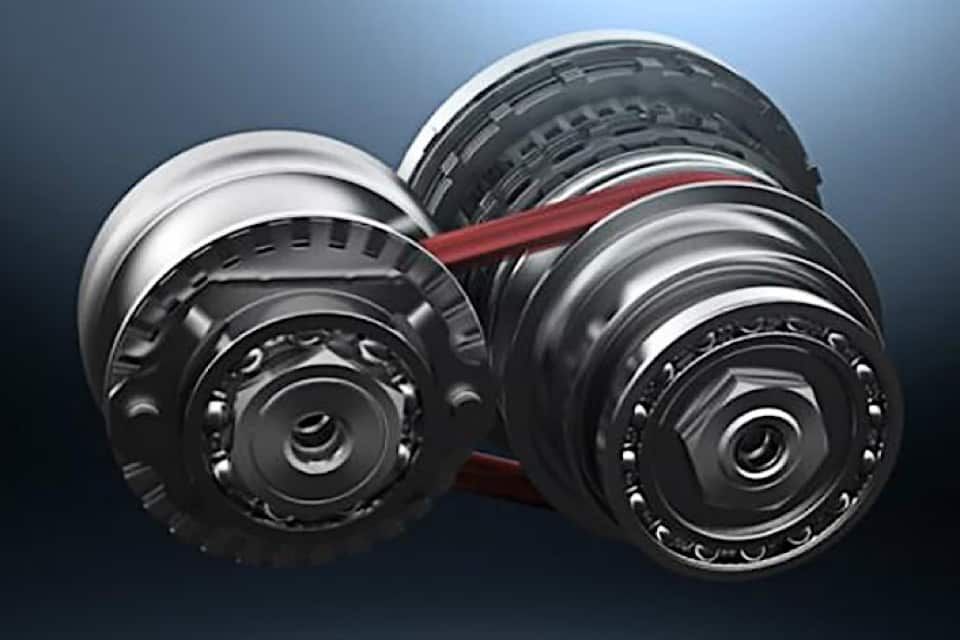Back To School!
Taylor Finnegan • August 19, 2025
Back-to-School Car Prep: Don’t Forget the Vehicles on Your To-Do List

Back-to-school season can feel like a whirlwind.
Between school supply shopping, packing dorm essentials, and organizing schedules, there’s no shortage of things to remember. But one important item that often gets overlooked is the car—whether it’s your own vehicle for the move-in trip or your child’s car that will be making daily commutes or heading off to college.
Why Your Child’s Car Matters
For students driving to school or college, their car becomes more than just transportation—it’s their lifeline. From commuting to class and work to making trips home, the last thing you want is for them to deal with unexpected breakdowns. Adding a vehicle checkup to the college to-do list is a simple step that can prevent bigger problems down the road.
- A pre-semester inspection should include:
- Oil and fluid levels – fresh oil and topped-off fluids keep the engine healthy.
- Tires – check tread depth and air pressure for safe handling in all weather.
- Brakes – reliable stopping power is non-negotiable.
- Battery – a weak battery will fail at the worst time.
- Lights & wipers – visibility is key for safe driving, especially during storms.
Think of it as giving your student’s car a clean bill of health before the semester begins.
Don’t Forget Your Own Car
If you’re helping with the move-in trip, remember your own car is also going to be under stress. Long drives loaded with boxes, back-to-back errands, and possible highway traffic can put extra strain on your vehicle. Having your car inspected before the big drive ensures you don’t end up stranded on the side of the road with a full load of dorm supplies.
Take the Stress Off
There’s enough pressure during back-to-school season—transportation shouldn’t be one of them. A quick checkup now saves time, money, and headaches later. With both cars ready to go, you’ll have peace of mind knowing the focus can stay on what matters most: supporting your student’s success.

The Truth About “Free A/C Checks” – What You Really Need to Know As the temperatures climb, many drivers see ads from shops offering a “Free A/C Check”. On the surface, it sounds like a great deal – who wouldn’t want their air conditioning looked at for free? But here’s the reality most customers don’t realize: those free checks usually aren’t as “free” as they appear. What a “Free A/C Check” Really Means In most cases, a free check consists of a quick inspection: a technician might turn on your A/C, check the vent temperature, and listen for obvious issues. But that’s only scratching the surface. To truly diagnose whether your system is working correctly, you need more than just a glance and a thermometer. Modern A/C machines don’t just “check” – they perform a process. At minimum, the system will: Evacuate the refrigerant from your system. Perform a leak test to ensure the system is sealed. Recharge the refrigerant (if no leaks are detected). That means even if you went in for a “free” check, once the machine is hooked up, you’re essentially getting an evac and recharge service. And yes – that comes with a cost. Why We Set Clear Expectations Upfront At Superior Transmissions and Auto, we want to be upfront and transparent. That’s why we explain to customers that any proper A/C diagnostic requires at least an evac and recharge. This process ensures we can: Verify the system has the correct amount of refrigerant. Test the system’s ability to hold pressure (leak test). Eliminate guesswork and provide accurate results. Skipping these steps or just “topping off” refrigerant without testing for leaks often masks the real problem and leaves you right back where you started—hot and frustrated. Why This Approach Saves You in the Long Run We know it might feel like you’re paying more up front compared to a “free” ad from another shop. But here’s why this saves you money (and stress): Accurate diagnosis the first time. No guessing, no wasted money on “maybe this will fix it.” Protects your system. Overcharging or undercharging refrigerant can damage expensive components. Long-term solution. If we find a leak or faulty part, you get answers right away, instead of a temporary band-aid. Bottom Line “Free A/C checks” are often just a way to get you in the door. The truth is, a proper diagnostic takes time, equipment, and refrigerant – which comes at a cost. At Superior Transmissions and Auto, we’d rather be honest with you from the start: a real A/C diagnostic will cost at least the price of an evac and recharge. It’s all about managing expectations, saving you money in the long run, and making sure you leave with cold air blowing – not just another half-answer.

Why General Vehicle Maintenance Matters – Even When Your Car Seems Fine It’s easy to put off car maintenance when everything feels like it’s running smoothly. If the engine starts, the brakes respond, and nothing seems out of the ordinary, many drivers assume their vehicle is in good shape. But the truth is, just because your car seems fine today doesn’t mean it’s ready for tomorrow’s conditions—especially when unpredictable weather or sudden road hazards come into play. Preventative maintenance is the key to ensuring safety, reliability, and long-term cost savings. Weather Doesn’t Wait for Breakdowns Hazardous weather conditions, such as torrential downpours, can quickly turn a routine drive into a dangerous situation. Heavy rain reduces visibility, increases stopping distances, and makes road surfaces slippery. The last thing you want to discover in that moment is that your worn tires can’t grip the road or your streaky wiper blades can’t clear your windshield. Tire tread depth is directly tied to traction. Worn-down tires can’t channel water effectively, which leads to hydroplaning—when your tires skim over water instead of gripping the pavement. This reduces steering control and can result in serious accidents. Windshield wipers may seem like a small detail, but when their blades are cracked, stiff, or worn, they can smear water instead of removing it. Reduced visibility during heavy rain is a common cause of collisions that could have been avoided with fresh wiper blades. Small Checks, Big Safety Routine maintenance like rotating tires, checking tread depth, and replacing wiper blades takes only minutes, yet the impact on safety is enormous. A well-maintained vehicle responds more predictably in emergencies and keeps you in control under hazardous conditions. Preventative maintenance also includes fluid checks, brake inspections, and ensuring your headlights and taillights are functioning properly—all crucial for driving in poor weather. The Long-Term Benefits of Preventative Care Ignoring small issues until they become noticeable problems can cost you more than just money. For example: Neglected tires wear unevenly, reducing lifespan and increasing the likelihood of blowouts. Skipping regular fluid changes can shorten the life of your transmission, engine, or cooling system. Overlooking brake service may lead to expensive rotor replacements instead of a simple pad change. By keeping up with maintenance, you’re not just saving yourself from future repair bills—you’re extending the life of your car and protecting your investment. Peace of Mind Behind the Wheel Preventative maintenance means you’re not relying on luck when facing unexpected weather or road conditions. Instead, you’re giving yourself the best possible chance to drive safely, avoid breakdowns, and stay in control no matter what the day brings. At the end of the day, taking care of your vehicle when it feels fine is what keeps it running fine.
Discover expert vehicle diagnostics at Superior Transmissions & Auto in New Windsor, NY. Enhance your car's performance today! Schedule an online appointment now.

When your check engine light pops on, your first instinct might be to stop at the nearest auto parts store for one of their famous “free code scans.” It sounds like a helpful service—quick, easy, and best of all, free. But what most drivers don’t realize is this is not a true diagnostic. In fact, it’s a sales tactic disguised as a service—and trusting it could cost you more time and money than you think. The Truth Behind Free Code Scans Let’s get this straight: the employee at the parts store is not a mechanic. They’re usually entry-level retail staff trained to plug in a basic code reader, print out a generic list of codes, and—here’s the catch—recommend a part for you to buy based on that code. The goal? Sell you a part. It’s not about fixing your car correctly; it’s about moving inventory off their shelves. The pressure to buy something right there on the spot is built into the entire system. But the hard truth is: The code doesn’t tell you exactly what’s wrong. The recommendation is usually just a guess. The part you're told to buy often doesn’t solve the issue. Why That Free Code Can Get Expensive Say your car throws a P0300 code (random cylinder misfire). The parts store might suggest spark plugs or a coil pack. So you buy it, install it—or try to bring it to a shop with that part in hand—only to find out the real issue was a fuel injector, vacuum leak, or low compression. Now you’ve wasted money and still have a misfiring engine. Even worse? Most reputable repair shops won’t install customer-supplied parts. Why? Because: There’s no warranty on the part or the labor if it fails. They can’t confirm the quality or compatibility of the part. There's no confirmed diagnosis It opens the door to liability and unnecessary headaches—for both parties. Trouble Codes ≠ Diagnosis Another major misconception is that a trouble code is a direct answer. It's not. Codes are starting points—clues that point technicians toward a system that needs further testing. For example: P0171 (system too lean) could be a vacuum leak, dirty mass air flow sensor, fuel delivery problem, or an exhaust leak—not necessarily the oxygen sensor the parts store says to replace. P0700 (transmission fault) tells you something’s wrong—but not what, where, or why. This is why the “buy this part” advice from a retail scanner often leads to the wrong repair—and more frustration. What Real Diagnostics Look Like At Superior Transmissions and Auto, our technicians don’t guess—we test. We use dealer-level scanners and OEM software to read live data, run system checks, and interpret not just what the vehicle is telling us, but why. We also back our findings with: Manufacturer service bulletins Professional databases like Identifix and iATN Hands-on experience and continuing education This allows us to pinpoint the actual root cause of a problem—not just treat a symptom. That’s the difference between guesswork and real diagnostics. Why Going to a Shop First Saves You Money By trusting your vehicle to trained professionals from the beginning, you: Avoid buying unnecessary parts Get accurate answers and a faster fix Benefit from parts and labor warranties Save money by doing it right the first time Final Thoughts Free code scans are designed to sell you parts—not to fix your car. And while it might seem convenient, those generic scans and part guesses often lead to wasted time, wasted money, and unnecessary stress. The next time that check engine light comes on, skip the sales pitch. Bring your vehicle to a shop with the right tools, the right training, and the right approach. Need answers—not guesses? At Superior Transmissions and Auto, we offer professional diagnostics backed by real experience and dealer-level equipment. Book an appointment today and let us help you get it fixed the right way—the first time.

At Superior Transmissions and Auto, we work with most major aftermarket warranty companies—including ProGuard, CarShield, Endurance, Cars Protection Plus, Empire State Warranty, Zurich, and more—to help customers get the most out of their coverage. But it’s important to understand that using an aftermarket warranty is a process, and it can take significantly longer than paying out of pocket—sometimes adding up to a week or more depending on the company. Here’s what that process looks like from start to finish, and why it’s more complex than many customers realize. Step 1: Preliminary Diagnosis & Claim Initiation When you bring your vehicle in with a concern and let us know you have an aftermarket warranty, we first perform a preliminary diagnosis. This involves verifying the issue, documenting what we’ve found, and gathering important vehicle information such as mileage, VIN, and service history. We then call the warranty company to open a claim. Some companies answer quickly; others may involve long hold times or require leaving a voicemail and waiting for a call back. Step 2: Waiting on Next Steps from the Warranty Once the claim is opened, the warranty company dictates the next steps. These can include: More in-depth testing or specific diagnostic procedures Verification of symptoms under certain conditions Sending out a third-party inspector to confirm the diagnosis and verify the vehicle is at the shop If an inspector is involved, they typically have 24–48 hours to arrive. Once here, they review the vehicle, take notes, and return their findings to the warranty company—which can take another 24–48 hours. Step 3: Approval (or Denial) Once the inspector’s report is submitted, the warranty company takes another 24–48 hours to review it and make a decision. They may approve the repair, deny it, or request further information. During this time, the customer’s only contact with the warranty company may be a quick call to confirm the vehicle is at our shop and why it was brought in. Step 4: Out-of-Pocket Costs If the claim is approved, we contact the customer to go over their portion of the cost. Despite what the selling dealer may have promised when the warranty was purchased, 9 times out of 10 there will be some kind of out-of-pocket expense, which may include: Taxes and fees Labor rate differences (many plans only cover up to $100/hr) Fluids, filters, and seals, which are commonly excluded Deductibles, which vary by plan We calculate this and let you know your responsibility before proceeding. Step 5: Parts Ordering & Repair Scheduling Once both the warranty and the customer approve the repair, we order the parts and begin working the vehicle into our shop’s workflow. Repairs don’t start until approvals are in and the parts have arrived. Until that point, your vehicle is essentially waiting in line. Step 6: Payment and Vehicle Release Once the work is complete, the invoice is finalized and submitted to the warranty company for payment. At that time, the customer is responsible for paying their portion. Some warranty companies may: Require additional verification before paying Send out another inspector to confirm the repair was completed Request more information before finalizing payment Because of this, we may hold the vehicle until payment is received from the warranty company. This protects all parties involved and ensures the claim process is fully closed out. Why It Takes Longer Using a warranty adds multiple layers of communication, paperwork, and back-and-forth between us and the warranty provider. Each warranty company operates a little differently, and some are far more responsive than others. Between phone calls, hold times, inspector visits, documentation, approvals, and follow-ups, the entire process can easily add days—or even a full week or more—to the repair timeline. It also requires significant office and administrative work on our end. In Summary We understand that you purchased your warranty expecting peace of mind—and in many cases, it does help with major repair costs. But it’s also important to be prepared for: Delays beyond our control Limited coverage in some areas Out-of-pocket costs Extra steps before repairs can begin We’re happy to work with your warranty company and advocate for the best possible outcome. But we also want to be fully transparent about what’s involved. If you have questions about your warranty coverage, give us a call—we’re here to help you navigate the process!
Expert differential rebuilds in New Windsor, NY at Superior Transmissions & Auto. Restore your vehicle's performance. Schedule an online appointment now!

When something feels off with your car—shifting weird, slipping gears, hesitation, or strange noises—it’s tempting to bring it to your regular mechanic for a quick answer. And more often than not, that answer sounds something like: “Let’s try a transmission flush.” Here’s the problem : a transmission flush isn’t always the answer. In fact, depending on your issue, it could make things a lot worse —and more expensive. At Superior Transmissions and Auto, we’ve seen this time and time again. Customers come to us after wasting money on “quick fixes” and getting nowhere, or worse, damaging their transmission further because the wrong service was done by someone who simply didn’t specialize in the system. Transmission Work Isn’t General Auto Work Think of it like your health: when your knee hurts, your primary care doctor might take a look, but if the issue is serious, they’ll send you to an orthopedic specialist. They know that trying to treat a complex problem with a basic approach can lead to bad outcomes. Your transmission deserves the same level of expert attention. Transmissions are among the most complicated systems in a vehicle. They involve hydraulics, electronics, precision components, and specific programming. General repair shops don’t always have the tools, software, or up-to-date technical service bulletins to properly diagnose a transmission issue—let alone rebuild or repair one the right way. Why Flushing Can Be the Wrong Move A flush is designed to replace the old transmission fluid with new, clean fluid. Sounds good, right? But if your transmission is already failing internally, flushing can loosen built-up debris and send it through the system—clogging filters, damaging solenoids, and accelerating failure. We’ve had customers come in after a flush was recommended (or done without consent) only to find their transmission now needs a full rebuild because damage that could have been caught and prevented early was ignored or made worse. The Cost of “Quick Fixes” Adds Up If you’ve been told to “just flush it,” add a $20 bottle of transmission fix from the auto parts store, or “drive it for a bit and see what happens,” you’re not alone. These patches rarely solve the root problem. Instead, you end up spending hundreds on band-aid solutions—only to eventually need the real repair anyway. The smarter move? Have your car looked at by a transmission expert the first time. We know what symptoms to look for. We have the tools to diagnose the issue properly. And we can tell you whether the problem is something simple—like a solenoid or sensor—or something more serious that needs to be addressed before more damage is done. Not All Mechanics Are Equipped the Same We’re not saying your general mechanic isn’t good at what they do. But just like no one doctor can do every surgery, no one mechanic can master every system. Transmission shops invest heavily in specialized diagnostic equipment, training, and access to OEM-level information that most general shops don’t have. If your check engine light points to a transmission code, your car is struggling to shift, or something just doesn’t feel right—it’s time to come to a shop that lives and breathes transmissions. Bottom line: Don’t flush your money—and your transmission—down the drain. Come see the experts at Superior Transmissions and Auto. We’ll get it right the first time.

What’s Really Going On If you own a Ford Focus—especially a model from 2012 to 2018—you’ve probably heard the words “transmission issue” more times than you’d like. The heart of most complaints? The DTC, or Dual-Clutch Transmission. At Superior Transmissions & Auto, we see these often and know exactly what makes them tick—and what makes them fail. What is a DTC Transmission, Anyway? DTC stands for Dual-Clutch Transmission. Think of it as a hybrid between a manual and an automatic transmission. It has two clutches—one for odd gears and one for even gears—allowing for faster, smoother gear shifts (in theory). It’s designed for fuel efficiency and performance, but in real-world driving, it often feels anything but smooth. Unlike a traditional automatic that uses a torque converter, the DTC in the Ford Focus behaves more like a computer-controlled manual transmission. It can feel jerky at low speeds, hesitate when shifting, or seem like it’s slipping—especially in stop-and-go traffic. Why the Ford Focus DTC is So Problematic The biggest issues with these transmissions usually boil down to the clutch system and internal actuators. In many cases, the vehicle will: Shudder on acceleration Struggle to find or hold a gear Flash the "Transmission Hot" warning Show DTC codes (diagnostic trouble codes) for clutch actuator failure or internal gear ratio errors Ford has acknowledged many of these problems through service bulletins and extended warranties—but even those come with limits. How We Handle Ford DTC Transmissions At Superior Transmissions & Auto, we don’t just throw parts at these issues. We diagnose them thoroughly to pinpoint exactly what’s going on. Often, the root cause is worn or contaminated clutch packs, failed shift actuators, or broken internal components in the TCM (Transmission Control Module). Here’s how we handle DTC repairs: 1. Complete Diagnostic Scan We start with a full scan of the transmission’s computer to identify stored trouble codes. This gives us insight into clutch position, actuator performance, and gear engagement. 2. Clutch Replacement The most common repair is replacing the dual-clutch assembly. These clutches wear prematurely, especially in traffic-heavy areas. We use upgraded parts and take the time to properly recalibrate everything during reinstallation. 3. Actuator & TCM Checks We test the transmission’s shift actuators and often recommend replacement if there are engagement issues or hesitation. In some cases, the TCM may also need programming or replacement. 4. Adaptive Relearn & Road Testing Once the repair is complete, we perform an adaptive relearn procedure and extensive road testing to ensure the transmission shifts correctly under all driving conditions. A Different Drive—And a Different Kind of Fix Driving a DTC-equipped Focus isn’t like driving a standard automatic—and that’s part of the confusion for many drivers. It’s normal for the car to feel a little “clunky” at low speeds. But grinding, slipping, or delayed shifts? Those are not normal. If you’re dealing with a misbehaving Focus transmission, don’t just live with it. And don’t let someone tell you “it’s just how they drive.” We’ve rebuilt countless DTCs, replaced dozens of clutches, and know these systems inside and out. Bring It to the Experts Not every shop will work on DTCs—some won’t touch them at all. At Superior Transmissions & Auto, we specialize in them. Whether you need a diagnostic, a clutch replacement, or a complete rebuild, we’ve got the tools, training, and experience to get your Focus back on the road—the right way. 📍 Located in New Windsor, NY 💻 Schedule your appointment right on our website! 🔧 Trust the shop that knows transmissions inside and out. Superior Transmissions & Auto Bringing transparency—and performance—back to auto repair.

Why That Matters for Your Car At Superior Transmissions & Auto, we’re proud to say we’re the only shop in the area that rebuilds Continuously Variable Transmissions (CVTs) — and that’s not just a cool brag. It speaks volumes about our experience, our commitment to our craft, and the level of trust you can place in us when your vehicle needs serious work. What Even Is a CVT? A CVT (Continuously Variable Transmission) is not your average transmission. Unlike traditional automatic or manual transmissions, which have a fixed number of gears, a CVT doesn’t have gears at all. Instead, it uses a system of pulleys and a steel belt to provide a seamless range of gear ratios. This allows for smoother acceleration, improved fuel efficiency, and a more consistent driving experience. Sounds great, right? It is — until something goes wrong. Why Most Shops Don’t Touch CVTs Here’s the thing: CVTs are a completely different animal than standard automatics. Rebuilding one isn’t just a matter of replacing worn-out clutches or seals. You need specialized tools, diagnostic software, and, most importantly, in-depth knowledge of how each specific CVT design works — and they vary a lot between manufacturers like Nissan, Subaru, Honda, and Toyota. Most general repair shops — even ones that dabble in transmissions — will tell you flat-out: “We don’t rebuild CVTs.” Why? Complex internals: CVTs rely on precise hydraulic and electronic controls. One wrong move and it’s toast. Lack of training: Most techs aren’t trained in CVT rebuild procedures, especially since many manufacturers don’t even sell internal parts. Special equipment required: You can’t rebuild a CVT with just a socket set and a transmission jack. The tools alone are a barrier. OEM discouragement: A lot of manufacturers push for full replacement instead of repair — leading shops to avoid the risk and effort of a rebuild. Why Superior Can and Does Rebuild CVTs At Superior Transmissions & Auto, we lean into the challenge. We’ve invested in the training, equipment, and expertise to properly rebuild CVTs — and we’ve been doing it successfully. We don’t shy away from complexity — we thrive in it. When other shops say, “It can’t be rebuilt,” we say, “It just hasn’t been rebuilt here yet.” We’ve rebuilt CVTs that other shops wrote off as scrap. In fact, we’ve had customers towed to us after being told their only option was a brand new transmission or a used junkyard transmission — and we were able to save them thousands by rebuilding instead. Ultimately giving them back a better product. The Bottom Line: CVT Trouble? You Found the Right Shop If your car has a CVT and it’s slipping, shaking, or just not moving, you need someone who knows what they’re doing. We’re not just another shop that “does transmissions.” We are transmission specialists — and more importantly, we’re CVT specialists, which is something you won’t find anywhere else around here. We’re here to do the work that others won’t — and we do it right. Give us a call or schedule an appointment online. If it’s got a CVT, we’ve got you covered.

Why Experience, Accuracy, and Doing It Right the First Time Matters At Superior Transmissions & Auto, we rebuild transmissions with precision, patience, and pride. But let’s be honest — rebuilding a transmission isn’t just mechanical work. It’s detective work. Every transmission we pull apart tells a story, and it’s our job to read every clue, ask the right questions, and get to the bottom of what went wrong… especially when a vehicle comes to us after it’s already been through the hands of a general repair shop. The Truth About Rebuilding After a Misdiagnosis We recently had a Ford pickup truck dropped off that had supposedly been “fixed” by another shop. According to the customer, they were told all it needed was a solenoid in the valve body. Sounds simple enough, right? But when we removed the valve body to inspect the solenoid — the same one that had just been installed — we noticed something troubling right away. It was already very dirty. The truck hadn’t even been driven much since the “repair,” so what gives? Now the real work begins. Did they install a used solenoid? Is it the correct solenoid for this specific transmission? These trucks use multiple solenoids that all look almost identical — is the right solenoid installed in the wrong location? These are questions that don’t come with easy answers unless you’ve got the experience, technical knowledge, and patience to dig into the details. And here’s the real kicker — because we couldn’t verify that the solenoid was new, correct, or properly placed, it became a sunk cost. We couldn’t reuse it in good conscience, and the customer had to pay again to do it the right way. The Cost of Doing It Wrong… and Then Right This isn’t uncommon. General repair shops often mean well, but transmissions are in a class of their own. They’re intricate systems where one small mistake — like installing the wrong part or skipping proper diagnosis — can snowball into a costly rebuild. Every time we receive a transmission that’s already been “worked on,” it adds hours (or even days) to our process. We’re not just rebuilding anymore — we’re unraveling someone else’s incomplete or incorrect work before we can even begin to fix the original problem. That time and effort cost money. But more importantly, cutting corners just isn’t an option when the goal is a reliable, long-lasting repair. What You’re Really Paying For When you bring your vehicle to a true transmission shop like ours, you’re not just paying for parts. You’re paying for: Diagnostic experience built over decades Manufacturer-specific training and knowledge Access to up-to-date tools and technical data A meticulous rebuild process that doesn’t guess We’ve rebuilt hundreds of transmissions. We’ve seen every “mystery problem,” mismatched solenoid, and reused gasket you can imagine. That’s why when we rebuild a transmission, we do it from top to bottom, the right way — with fresh, verified parts and detailed attention to every component. Because the truth is, you don’t want to find yourself paying twice for the same job. You want it done right the first time — by someone who knows the difference between a worn clutch pack and a misdiagnosed valve body. In the End: Transmission Work Is an Investigation Just like a detective, we follow the clues, eliminate suspects, and find the real cause of the failure. And sometimes, solving the case means starting over from scratch because someone else tried to take a shortcut. We’re not the cheapest shop in town — and we’re proud of that. What we offer is confidence, peace of mind, and a transmission rebuilt to last. That Ford pickup may have had a rough start elsewhere, but it left our shop with a clean slate — and a fresh transmission built the right way. Need transmission work done right the first time? Make your appointment easily right on our website. Let’s solve the mystery together — and keep you on the road for the long haul.




